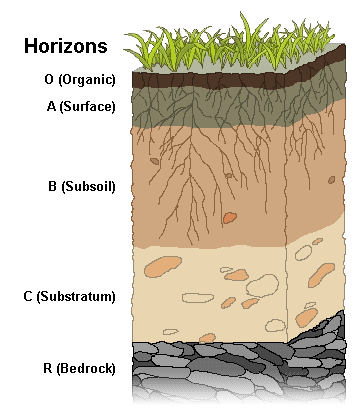Soil Profile – Geography Notes – For W.B.C.S. Examination.
মাটির প্রোফাইল – ভূগোল নোট – WBCS পরীক্ষা।
The soil is the topmost layer of the earth’s crust mainly composed of organic minerals and rock particles that support life. A soil profile is a vertical cross-section of the soil, made of layers running parallel to the surface. These layers are known as soil horizons.Continue Reading Soil Profile – Geography Notes – For W.B.C.S. Examination.
The soil is arranged in layers or horizons during its formation. These layers or horizons are known as the soil profile. It is he vertical section of the soil that is exposed by a soil pit. The layers of soil can easily be identified by the soil colour and size of soil particles. The different layers of soil are:
- Topsoil
- Subsoil
- Parent rock
Each layer of soil has distinct characteristics.
Soil profile helps in determining the role of the soil as well. It helps one to differentiate the given sample of soil from other soil samples based on factors like its colour, texture, structure, and thickness, as well as its chemical composition.
Layers of Soil
The soil profile is composed of a series of horizons or layers of soil stacked one on top of the other. These layers or horizons are represented by letters O, A, E, C, B and R.
The O-Horizon
The O horizon is the upper layer of the topsoil which is mainly composed of organic materials such as dried leaves, grasses, dead leaves, small rocks, twigs, surface organisms, fallen trees, and other decomposed organic matter. It contains about 20 to 30% of organic matter. This horizon of soil is often black brown or dark brown in colour and this is mainly because of the presence of organic content.
The A-Horizon or Topsoil
This layer is rich in organic material and is known as the humus layer. This layer consists of both organic matter and other decomposed materials. The topsoil is soft and porous to hold enough air and water.
In this layer, the germination of seeds takes place and new roots are produced which grows into a new plant. This layer consists of microorganisms such as earthworms, fungi, bacteria, etc.
The E-Horizon
This layer is composed of nutrients leached from the O and A horizons. This layer is more common in forested areas and has lower clay content.
The B-Horizon or Subsoil
It is the subsurface horizon, present just below the topsoil and above the bedrock. It is comparatively harder and compact than topsoil. It contains less humus, soluble minerals, and organic matter. It is a site of deposition of certain minerals and metal salts such as iron oxide.
This layer holds enough water than the topsoil and is lighter brown due to the presence of clay soil. The soil of horizon-A and horizon-B is often mixed while ploughing the fields.
The C-Horizon or Saprolite
This layer is devoid of any organic matter and is made up of broken bedrock. This layer is also known as saprolite. The geological material present in this zone is cemented.
The R-Horizon
It is a compacted and cemented layer. Different types of rocks such as granite, basalt and limestone are found here.
Please subscribe here to get all future updates on this post/page/category/website


 +919674493673
+919674493673  mailus@wbcsmadeeasy.in
mailus@wbcsmadeeasy.in







































































































